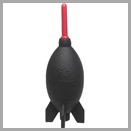I’ve been using the pretext of touring my camera bag to carry on a general discussion of photographic gear. So far we’ve covered the camera bag, the camera body itself, lenses and filters. In this installment we will cover miscellaneous items.
If you haven’t seen the previous articles, here are the links:
Photographic Gear – A Tour of a Photographer’s Camera Bag
Photographic Gear – the Camera Body
To complete the camera bag tour let’s look at some of the accessories we accumulate to support our passion for photography.
Cleanliness
Let’s begin with that little pouch in the upper right hand corner. It contains, among other things, a microfiber cloth. It is used to clean lenses and filters. It’s important that we keep everything clean including the front elements of our lenses and/or the filters we place on them.
 The microfiber cloth is designed to clean without scratching. It can clear away dust and smudges. But I prefer a no-contact method and for that I use my Giotto Rocket. It’s designed to blow dust from our sensors but it blows dust from the front of lenses equally as well. So that’s my first choice for cleaning the lens. If that doesn’t get all the dust I reach for the microfiber cloth to finish the job.
The microfiber cloth is designed to clean without scratching. It can clear away dust and smudges. But I prefer a no-contact method and for that I use my Giotto Rocket. It’s designed to blow dust from our sensors but it blows dust from the front of lenses equally as well. So that’s my first choice for cleaning the lens. If that doesn’t get all the dust I reach for the microfiber cloth to finish the job.
But, as good as those two things are, neither of them can clean water drops from the lens. This of course can occur when you’re photographing near waterfalls, or the surf on the ocean or, in the rain. For these situations, a small square of chamois is perfect. It doesn’t scratch the lens but it soaks up the water.
Continue reading “Photographic Gear – Miscellaneous”
(86)


